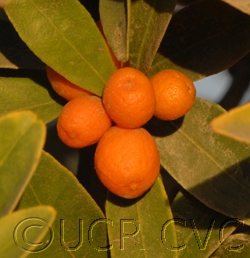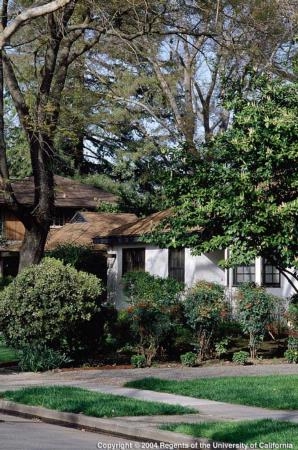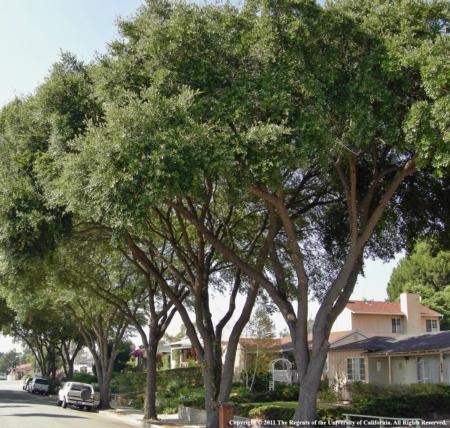
Posts Tagged: ornamental plants and trees
Estimating landscape irrigation needs
Our office has recently been receiving calls about water bills and landscape plants. The rising cost of water will only continue to influence plant choices as we move forward.
UC’s A Guide to Estimating Irrigation Water Needs of Landscape Plantings in California: The Landscape Coefficient Method and Water Use Classification of Landscape Species is a helpful resource and can be accessed online in its entirety.
Color photos, tables, and fully explained formulas can be found throughout this highly organized 160 publication. Chapters include:
- Estimating water requirements for crops and turf
- Estimating water needs for landscape plantings
- Using the landscape coefficient formula
- Using the landscape coefficient to estimate landscape evapotranspiration
- Irrigation efficiency and calculating the total amount of water to apply
- Putting it all together: A worksheet for calculations
- Using water estimates in landscape planning and management
- Special planting situations
Asian Citrus Psyllid host plants
Asian citrus psyllid, has not recently received much attention in the news media. However the pest, and the deadly bacterial disease it can carry, are still of great concern.
The Asian citrus psyllid (ACP) has now been found in eight California counties. Quarantines are in place. The psyllid by itself is not much of a problem; it is its ability to spread the fatal disease that has the potential to devastate both the California citrus industry and backyard citrus throughout the state.
Huanglongbing (HLB) is the name of the disease ACP can carry. Citrus and closely related plants are at risk. The disease is transmitted between plants by the psyllid. The psyllids transmit the disease to healthy plants and trees. After feeding on an infected plant, the ACP will transmit HLB to every other plant it feeds on.
While much outreach has focused on citrus trees, it is important to remember there are other plants that can host both ACP and HLB. This list from the University of Florida provides both the common and Latin plant name for many known hosts. Hosts include: curry leaf, ornamental orange-jasmine, and all the varieties of citrus, including kumquat, mandarin, grapefruit, orange and all of their hybrids.
Please remember to check your citrus and closely related plants regularly for signs of ACP or HLB. General information about this pest disease complex can be found on this section of the CDFA website. For local updates, the Ventura County ACP Task Force is a great source of information.
Buy it where you burn it
As the season for outdoor activities and gatherings gets into full swing, we would like to remind you to burn only local wood at campfires and cookouts.
Why is burning only local wood important? Several destructive invasive pests attack trees and continue to inhabit the wood after the tree has died. When and if an infested tree is cut up and used for firewood the pests go along for the ride and broaden their range. The pests can be extremely small and invisible to the naked eye.
These pests include:
- The Red Bay Ambrosia beetle (RBA). This tiny insect and the fungus it carries can kill a healthy avocado tree in six months or less. Laurel Wilt Disease caused by the fungus carried by RBA is already established in the South Eastern portion of our country and is expected to travel to our state. RBA has the potential to devastate our avocado industry along with backyard trees.
- The Gold Spotted Oak Borer (GSOB) is already in our state and is responsible for killing tens of thousands of oak trees. The loss of oak trees, especially in the wild brings many negative impacts: loss of wildlife habitat, greater risk of erosion and catastrophic fire, invasion of noxious weeds, as well as safety risks related to falling trees or branches. Additional information about GSOB can be found at this website.
- The Tea Shot Hole Borer is also in California, but to date there have been no reports of the potentially deadly fungal damage it can spread. The Tea Shot Hole Borer is also a serious pest of avocado trees. Other hosts include: castor bean plant, black locust, lychee, and acer.
Please do what you can to minimize the spread of these destructive invasive species. Remember when it comes to firewood -- buy it where you burn it!
gsob.org
Over the last 10 years, the Goldspotted Oak Borer (GSOB) has killed approximately 80,000 oak trees in San Diego County – including many large trees that were hundreds of years old.
To date GSOB has caused significant economic, ecological, cultural, and aesthetic losses in San Diego County. The costs of dead tree and infested wood alone is staggering.
GSOB (Agrilus Auroguttatus) is an invasive insect in California. Because it is a non-native pest there are not natural defense mechanisms to keep this insect in check. There is concern among experts that GSOB will continue to move north through California. Susceptible oak species are: coast live oak, California black oak, and canyon live oak.
It is highly suspected that GSOB entered California in firewood. GSOB larvae can live under the bark of dead oaks for over a year before exiting as adults. It is likely GSOB has spread so quickly in San Diego County via firewood movement. Because of this, it is extremely important to be mindful of where your firewood comes from. The movement of infested firewood could easily establish this destructive pest throughout the state.
To learn more about GSOB, or to get involved in preventing its spread, please see the gsob.org website.
And remember, to protect California’s Forest – Buy and Burn Local Firewood! Don’t move it around!
Ornamental Plants and Trees
California is a highly urbanized state with an expanding population. Planned landscapes and gardens are essential for Californians to maintain health promoting environments via urban landscapes. California’s urban landscapes are complex plant systems that provide essential functional, environmental, recreational, and psychological benefits for urban residents.
In 1995 landscapes covered 1.369 million acres in California, which is the most recent reliable data published. This planted area has undoubtedly grown with population increases since that time. In addition to creating beauty and health benefits, the ornamental plant and tree industry creates and supports many jobs and economic activity within the state.
The landscape industry is estimated to have a statewide economic activity well over $5 billion annually, with approximately 60% centered in Southern California. When indirect effects of tourism are included, the economic impact and importance of landscape horticulture nearly doubles. Examples of related employment numbers and their approximate memberships are: licensed landscape contractors (2,500), landscape architects (2,000), sod growers (4), arborists and city street tree managers (800+), urban water agencies (100+), along with urban forestry agencies and groups, irrigation managers and engineers, and municipal parks, planning and public works departments.
Landscapes are populated by two major categories of plants: turfgrasses, and woody ornamentals such as trees, shrubs and vines.
Turfgrass is the largest irrigated crop in the U.S. with an estimated land cover of 40.5 million acres or nearly 2% of the total area of the continental U.S.. The turfgrass industry in California is arguably the largest in the world with the economic impact from golf alone estimated to be more than $15 billion annually.
Turfgrass plays an important role in the landscape and in the lives of Californians. It is aesthetically pleasing and provides a safer, cushioned surface for sports and recreational activities. Turfgrass reduces surface temperature by transpirational cooling. It also lessens glare, noise, soil erosion, and dust thereby reducing air pollution and allergens. Turfgrass provides habitat for wildlife and reduces wildfire hazard. It has been demonstrated to be an effective bio-filter for applied pesticides and nutrients, and for pharmaceuticals and other xenobiotics (substances not normally found) in reclaimed water for irrigation.
Turfgrass also helps to remove carbon from the environment. Long-term soil testing data from Colorado golf courses were used to estimate soil C sequestration. Turf on the average golf course in their study sequestered as much as 450 kg (1000 pounds) C per acre per year, which is 1.5 to 3 times greater than soils under agricultural production.
Trees are perhaps the most emblematic and valuable individuals in landscapes. In part these valuable landscape elements provide shade, which in turn provides energy savings in shaded buildings. Trees absorb and store carbon and thus play a role in moderating global climate change. Trees also mitigate landscape noise, and provide an aesthetic environment where people live.
Unfortunately, the average life span of trees in urban landscapes is only about seven years. Though some studies have called for the survival statistics to be revised upward to 19-28 years, many urban trees still fail to establish or mature to serve their potential landscape functions. Research on sustaining trees in urban environments is more critical than ever as we rely on them for energy savings, carbon sequestration and the other benefits they add to urban landscapes. It is imperative that we find ways to extend the lifespan of these critical landscape elements in urban settings.
Jim Downer is a UCCE Farm Advisor in Ventura County. His specialties include pathology of landscape ornamental, Phytophtohora Root Rot, Mulches, Potting soils, Palm horticulture, and Arboriculture. Additional information about his research can be found here.





